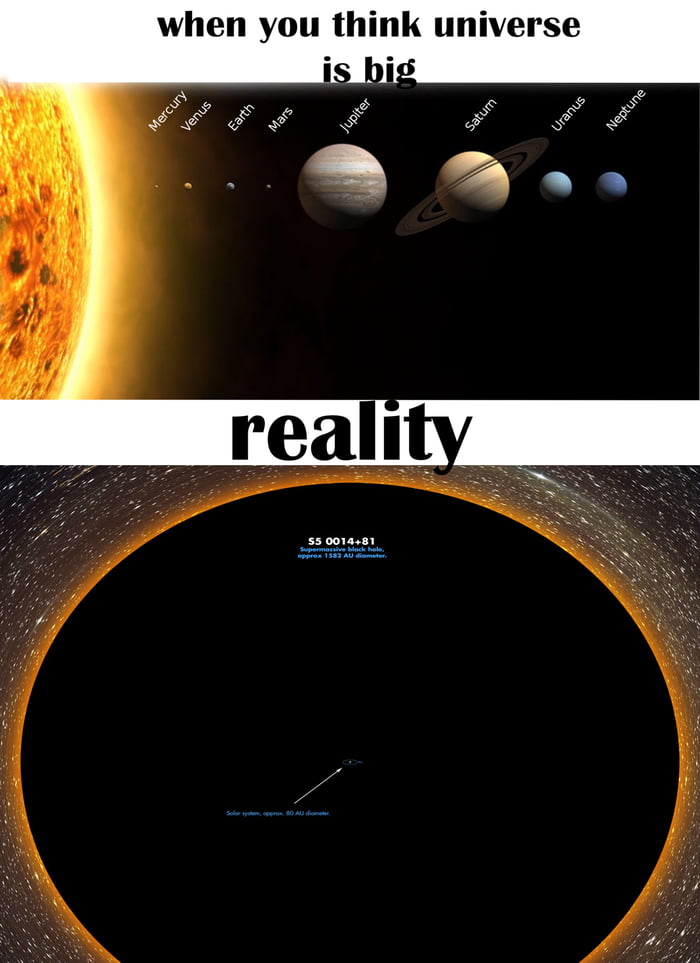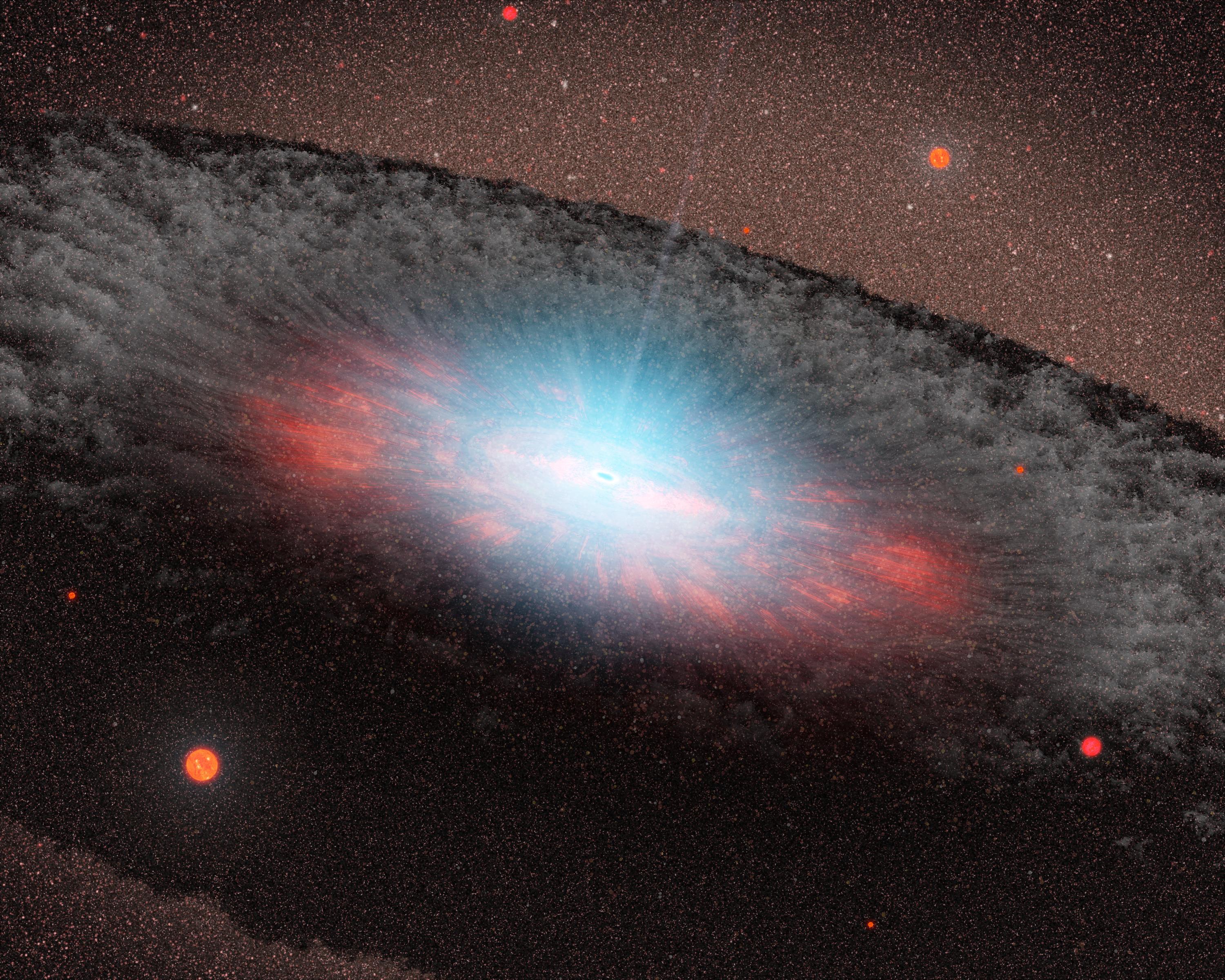
Supermassive BlackHole' "S5 0014+81" vs Our SolarSystem comparison 😱
But what makes this object, known as S5 0014+81, so special is that it got so big and massive so quickly. Its light comes to us from a time when the Universe was only 1.6 billion years old: just.

i roast a black hole and it's name is S5 0014+81 YouTube
Meet S5 0014+81, one of the most powerful things in the known universe. This colossal beast is actually a distant quasar (some 12.1 billion light-years away).

S5 0014+81 YouTube
S5 0014+81 is a distant, compact, hyperluminous, broad-absorption-line quasar, or blazar, located near the high declination region of the constellation Cepheus, near the North Equatorial Pole. S5 0014+81. Artist's impression of a hyperluminous quasar similar to S5 0014+81 surrounded by a thick accretion disk with two powerful jets.

S5 0014+81:宇宙中最亮的类星体之一,比银河系亮25000倍 好汉科普
The brightest, most luminous objects in the entire Universe are neither stars nor galaxies, but quasars, like S5 0014+81. An illustration of an active black hole, one that accretes matter and.

The is S5 0014+81, the largest supermassive black hole in the universe
The most luminous quasar : S5 0014 +81 Kuhr, H. ; Liebert, J. W. ; Strittmatter, P. A. ; Schmidt, G. D. ; Mackay, C. It is shown that, whereas S5 0014+81 is almost certainly the most luminous quasar discovered so far, its other properties are similar to those of other high-z quasars.

Supermassive black hole "S5 0014+81" compared to our solar system r/space
3. S5 0014+81. Artist's impression of S5 0014+81, one of the most massive black holes. This is the most interesting one in the list. S5 0014+81 has a mass of about 40 billion solar masses. It is actually a blazar. Blazars are the most energetic of all sub classes of quasars.

Our solar system in the middle of the s5 0014+81 (size) black hole 9GAG
Instead, S5 0014+81 is over 22 billion light years away; we see it as it was just 1.6 billion years after the Big Bang. Simulations of various gas-rich processes, such as galaxy mergers, indicate.

Pirulo Cósmico Un monstruo en el espacio profundo S5 0014+81
The host galaxy of S5 0014+81 is an FSRQ (Flat Spectrum Radio Quasar) blazar, a giant elliptical galaxy that hosts a supermassive black hole at its center. In 2009, a team of astronomers using the Swift spacecraft used the luminosity of S5 0014+81 to measure the mass of its black hole. They found it to be about 10,000 times more massive than the black hole at the center of our galaxy, or.

Black Holes From Sagittarius A* S5 0014+81 2nd Update YouTube
TON 618 is a supermassive black located just over 10 billion light years away. With a mass of 66 billion suns, it is one of the most massive black holes ever found in the universe. TON 618 was first observed in 1957, yet at the time, scientists had no idea what it was.

S5 0014+81 FILASTOX
Introduction Comparisons of large and small black holes in galaxy OJ 287 to the Solar System A supermassive black hole (SMBH) is an extremely large black hole, on the order of hundreds of thousands to billions of solar masses ( M☉ ), and is theorized to exist in the center of almost all massive galaxies.

EarthSunUY ScutiS5 0014+81 YouTube
Zoeller Pump Company, based out of Louisville, Kentucky, who has provided world-class residential and commercial water pumps and accessories since 1939, announces the newest product to their line of high water alarms, the Qwik Alarm™. The Qwik Alarm (10-5090) was designed to be paired with the Qwik Jon Premier upflush system where a separate.

Quasar S5001481 at 12.1 Billion Lightyears This Quasar o… Flickr
S5 0014+81 1. TON 618 8. Central black hole of Phoenix Cluster Powerful radio jets from the supermassive black hole at the center of a galaxy in the Phoenix Cluster | The cavities within the blue region is imaged by NASA's Chandra X-ray observatory. Solar Mass: 2 ×1010

Stargazer (stargazer_official_) on Instagram “S5 0014+81 is a distant
1.Phoenix A* Black Hole Phoenix A* is a supermassive black hole located in the southern constellation of Phoenix. It is known to be the largest and most massive black hole ever discovered with 100 billion solar masses which means 100 billion Suns can fit into this giant beast. High Quality illustration of Phoenix Black Hole.

S5 0014+81 YouTube
In 1891, the object OJ 287 , 3.5 billion light years distant and a blazar itself, optically bursted. The most massive pair of black holes in the known Universe is OJ 287, whose gravitational waves.

What are white holes, and do they really exist? Big Think
S5 0014+81, The largest known supermassive black hole compared to our solar system. Not really to scale Archived post. New comments cannot be posted and votes cannot be cast. 43K Sort by: Open comment sort options klydeiscope • 7 yr. ago This video always gives me chills when they show the mass in number of suns. 1.8K skorpiolt • 7 yr. ago

Gözlemlenebilir Evrenimizin En Büyük Kütleye Sahip Kara Deliği S5 0014
OJ 287 is a BL Lacertae or "BL Lac" object-a type of galaxy featuring an active galactic nucleus, and was first detected by radio wavelengths. The OJ 287 black hole displays a distinct 11-12 year periodic variation in its optical light curve, which suggests that it is a binary supermassive black hole.